- Home
- ABOUT US
- ABOUT VEYSEL BABA
- REDFOX ART HOUSE VIRTUAL TOUR
- MY LAST WILL TESTAMENT
- NOTES ON HUMANITY AND LIFE
- HUMAN BEING IS LIKE A PUZZLE WITH CONTRADICTIONS
- I HAVE A WISH ON BEHALF OF THE HUMANITY
- WE ARE VERY EXHAUSTED AS THE DOOMSDAY IS CLOSER
- NO ROAD IS LONG WITH GOOD COMPANY
- THE ROAD TO A FRIENDS HOUSE IS NEVER LONG
- MY DREAMS 1
- MY DREAMS 2
- GOLDEN WORDS ABOUT POLITICS
- GOLDEN WORDS ABOUT LOVE
- GOLDEN WORDS ABOUT LIFE
- GOLDEN WORDS ABOUT DEATH
- VEYSEL BABA ART WORKS
- SHOREDITCH PARK STORIES
- EXAMPLE LIVES
- ART GALLERY
- BOOK GALLERY
- MUSIC GALLERY
- MOVIE GALLERY
- Featured Article
- Home
- EXAMPLE LIVES
- Alexandre Dumas
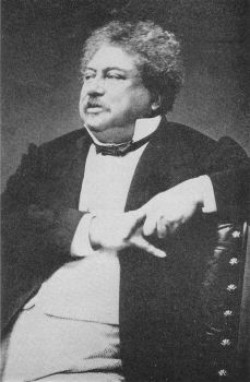
Alexandre Dumas
Alexandre Dumas (English /duːmˈɑː, djuː-/, French: [alɛksɑ̃dʁ dyma], born Dumas Davy de la Pailleterie [dyma davi də la pajətʁi]; 24 July 1802 – 5 December 1870),[1] also known as Alexandre Dumas, père, was a French writer. His works have been translated into nearly 100 languages, and he is one of the most widely read French authors. Many of his historical novels of high adventure were originally published as serials, including The Count of Monte Cristo, The Three Musketeers, Twenty Years After, and The Vicomte de Bragelonne: Ten Years Later. His novels have been adapted since the early twentieth century for nearly 200 films. Dumas' last novel, The Knight of Sainte-Hermine, unfinished at his death, was completed by a scholar and published in 2005, becoming a best seller. It was published in English in 2008 as The Last Cavalier.
Prolific in several genres, Dumas began his career by writing plays, which were successfully produced from the first. He also wrote numerous magazine articles and travel books; his published works totalled 100,000 pages.[2] In the 1840s, Dumas founded the Théâtre Historique in Paris.
His father, General Thomas-Alexandre Davy de la Pailleterie, was born in the French colony of Saint-Domingue (present-day Haiti) to a French nobleman and an enslaved African woman. At age 14 Thomas-Alexandre was taken by his father to France, where he was educated in a military academy and entered the military for what became an illustrious career.
Dumas' father's aristocratic rank helped young Alexandre acquire work with Louis-Philippe, Duke of Orléans. He later began working as a writer, finding early success. Decades later, in the election of Louis-Napoléon Bonaparte in 1851, Dumas fell from favour and left France for Belgium, where he stayed for several years. Upon leaving Belgium, Dumas moved to Russia for a few years before going to Italy. In 1861, he founded and published the newspaper L'Indipendente, which supported the Italian unification effort. In 1864, he returned to Paris.
Though married, in the tradition of Frenchmen of higher social class, Dumas had numerous affairs (allegedly as many as forty). In his lifetime, he was known to have at least four illegitimate or "natural" children; although twentieth-century scholars found that Dumas fathered another three "natural" children. He acknowledged and assisted his son, Alexandre Dumas, to become a successful novelist and playwright. They are known as Alexandre Dumas père (father) and Alexandre Dumas fils (son). Among his affairs, in 1866, Dumas had one with Adah Isaacs Menken, an American actress then less than half his age and at the height of her career.
The English playwright Watts Phillips, who knew Dumas in his later life, described him as "the most generous, large-hearted being in the world. He also was the most delightfully amusing and egotistical creature on the face of the earth. His tongue was like a windmill – once set in motion, you never knew when he would stop, especially if the theme was himself."[3]
Early life

Dumas Davy de la Pailleterie (later known as Alexandre Dumas) was born in 1802 in Villers-Cotterêts in the department of Aisne, in Picardy, France. He had two older sisters, Marie-Alexandrine (born 1794) and Louise-Alexandrine (born 1796, died 1797).[4] Their parents were Marie-Louise Élisabeth Labouret, the daughter of an innkeeper, and Thomas-Alexandre Dumas. Thomas-Alexandre had been born in the French colony of Saint-Domingue (now Haiti), the mixed-race, natural son of the marquis Alexandre Antoine Davy de la Pailleterie, a French nobleman and général commissaire in the artillery of the colony, and Marie-Cessette Dumas, a slave of Afro-Caribbean ancestry. At the time of Alexandre's birth, his father was impoverished. It is not known whether she was born in Saint-Domingue or in Africa, nor is it known from which African people her ancestors came.[5][6][7]
Brought as a boy to France by his father and legally freed there, Thomas-Alexandre Dumas Davy was educated in a military school and joined the army as a young man. As an adult, Thomas-Alexandre used his mother's name, Dumas, as his surname after a break with his father. Dumas was promoted to general by the age of 31, the first soldier of Afro-Antilles origin to reach that rank in the French army.[8] He served with distinction in the French Revolutionary Wars. He became general-in-chief of the Army of the Pyrenees, the first man of colour to reach that rank. Although a general under Bonaparte in the Italian and Egyptian campaigns, Dumas had fallen out of favour by 1800 and requested leave to return to France. On his return, his ship had to put in at Taranto in the Kingdom of Naples, where he and others were held as prisoners of war.
His father died of cancer in 1806 when Alexandre was four. His widowed mother Marie-Louise could not provide her son with much of an education, but Dumas read everything he could and taught himself Spanish. Although poor, the family had their father's distinguished reputation and aristocratic rank to aid the children's advancement. In 1822, after the restoration of the monarchy, the 20-year-old Alexandre Dumas moved to Paris. He acquired a position at the Palais Royal in the office of Louis-Philippe, Duke of Orléans.[citation needed]
Career
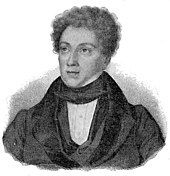
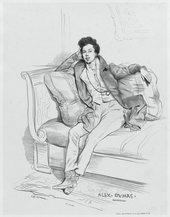
While working for Louis-Philippe, Dumas began writing articles for magazines and plays for the theatre. As an adult, he used his slave grandmother's surname of Dumas, as his father had done as an adult.[9] His first play, Henry III and His Courts, produced in 1829 when he was 27 years old, met with acclaim. The next year, his second play, Christine, was equally popular. These successes gave him sufficient income to write full-time.
In 1830, Dumas participated in the Revolution that ousted Charles X and replaced him with Dumas' former employer, the Duke of Orléans, who ruled as Louis-Philippe, the Citizen King. Until the mid-1830s, life in France remained unsettled, with sporadic riots by disgruntled Republicans and impoverished urban workers seeking change. As life slowly returned to normal, the nation began to industrialise. An improving economy combined with the end of press censorship made the times rewarding for Alexandre Dumas' literary skills.
After writing additional successful plays, Dumas switched to writing novels. Although attracted to an extravagant lifestyle and always spending more than he earned, Dumas proved to be an astute marketer. As newspapers were publishing many serial novels, in 1838, Dumas rewrote one of his plays as his first serial novel, Le Capitaine Paul. He founded a production studio, staffed with writers who turned out hundreds of stories, all subject to his personal direction, editing, and additions.
From 1839 to 1841, Dumas, with the assistance of several friends, compiled Celebrated Crimes, an eight-volume collection of essays on famous criminals and crimes from European history. He featured Beatrice Cenci, Martin Guerre, Cesare and Lucrezia Borgia, as well as more recent events and criminals, including the cases of the alleged murderers Karl Ludwig Sand and Antoine François Desrues, who were executed.
Dumas collaborated with Augustin Grisier, his fencing master, in his 1840 novel, The Fencing Master. The story is written as Grisier's account of how he came to witness the events of the Decembrist revolt in Russia. The novel was eventually banned in Russia by Czar Nicholas I, and Dumas was prohibited from visiting the country until after the Czar's death. Dumas refers to Grisier with great respect in The Count of Monte Cristo, The Corsican Brothers, and in his memoirs.
Dumas depended on numerous assistants and collaborators, of whom Auguste Maquet was the best known. It was not until the late twentieth century that his role was fully understood.[10] Maquet is known to have outlined the plot of The Count of Monte Cristo and made substantial contributions to The Three Musketeers and its sequels, as well as to several of Dumas' other novels. Their method of working together was for Maquet to propose plots and write drafts, while Dumas added the details, dialogues, and the final chapters. Dumas wrote the short novel Georges (1843), which uses ideas and plots later repeated in The Count of Monte Cristo.[11] Maquet took Dumas to court to try to get authorial recognition and a higher rate of payment for his work. He was successful in getting more money, but not a by-line.[10][12]
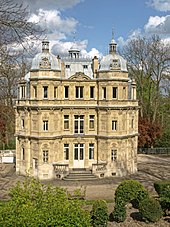
Dumas' novels were so popular that they were soon translated into English and other languages. His writing earned him a great deal of money, but he was frequently insolvent, as he spent lavishly on women and sumptuous living. (Scholars have found that he had a total of 40 mistresses.[13]) In 1846, he had built a country house outside Paris at Le Port-Marly, the large Château de Monte-Cristo, with an additional building for his writing studio. It was often filled with strangers and acquaintances who stayed for lengthy visits and took advantage of his generosity. Two years later, faced with financial difficulties, he sold the entire property.
Dumas wrote in a wide variety of genres and published a total of 100,000 pages in his lifetime.[2] He also made use of his experience, writing travel books after taking journeys, including those motivated by reasons other than pleasure. After King Louis-Philippe was ousted in a revolt, Louis-Napoléon Bonaparte was elected president. As Bonaparte disapproved of the author, Dumas fled in 1851 to Brussels, Belgium, which was also an effort to escape his creditors. About 1859, he moved to Russia, where French was the second language of the elite and his writings were enormously popular. Dumas spent two years in Russia before leaving to seek different adventures. He published travel books about Russia.
In March 1861, the kingdom of Italy was proclaimed, with Victor Emmanuel II as its king. Dumas travelled there and for the next three years participated in the movement for Italian unification. He founded and led a newspaper, Indipendente. Returning to Paris in 1864, he published travel books about Italy.
Despite Dumas' aristocratic background and personal success, he had to deal with discrimination related to his mixed-race ancestry. In 1843, he wrote a short novel, Georges, that addressed some of the issues of race and the effects of colonialism. His response to a man who insulted him about his African ancestry has become famous. Dumas said:
My father was a mulatto, my grandfather was a Negro, and my great-grandfather a monkey. You see, Sir, my family starts where yours ends.[14][15]
Personal life
On 1 February 1840, Dumas married actress Ida Ferrier (born Marguerite-Joséphine Ferrand) (1811–1859).[16] He had numerous liaisons with other women and was known to have fathered at least four children by them:
- Alexandre Dumas, fils (1824–1895), son of Marie-Laure-Catherine Labay (1794–1868), a dressmaker. He became a successful novelist and playwright.
- Marie-Alexandrine Dumas (5 March 1831 – 1878), the daughter of Belle Krelsamer (1803–1875).
- Micaëlla-Clélie-Josepha-Élisabeth Cordier (born 1860), the daughter of Emélie Cordier.
- Henry Bauer, the son of a woman whose surname was Bauer.
About 1866, Dumas had an affair with Adah Isaacs Menken, a well-known American actress. She had performed her sensational role in Mazeppa in London. In Paris, she had a sold-out run of Les Pirates de la Savanne and was at the peak of her success.[17]
These women were among Dumas' nearly 40 mistresses found by scholar Claude Schopp, in addition to three natural children. Schopp has been researching Dumas for decades, primarily his writings.[13]
Death and legacy
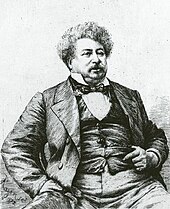
At his death in December 1870, Dumas was buried at his birthplace of Villers-Cotterêts in the department of Aisne. His death was overshadowed by the Franco-Prussian War. Changing literary fashions decreased his popularity. In the late twentieth century, scholars such as Reginald Hamel and Claude Schopp have caused a critical reappraisal and new appreciation of his art, as well as finding lost works.[2]
In 1970, the Alexandre Dumas Paris Métro station was named in his honour. His country home outside Paris, the Château de Monte-Cristo, has been restored and is open to the public as a museum.[citation needed]
Researchers have continued to find Dumas works in archives, including the five-act play, The Gold Thieves, found in 2002 by the scholar Réginald Hamel (fr) in the Bibliothèque Nationale de France. It was published in France in 2004 by Honoré-Champion.[2]
Frank Wild Reed (1874–1953), the older brother of Dunedin publisher A. H. Reed, was a busy Whangarei pharmacist who never visited France, yet he amassed the greatest collection of books and manuscripts relating to Dumas outside France. It contains about 3350 volumes, including some 2000 sheets in Dumas' handwriting and dozens of French, Belgian and English first editions. This collection was donated to Auckland Libraries after his death.[18] Reed wrote the most comprehensive bibliography of Dumas.[19][20]
In 2002, for the bicentennial of Dumas' birth, French President Jacques Chirac had a ceremony honouring the author by having his ashes re-interred at the mausoleum of the Panthéon of Paris, where many French luminaries were buried.[2][13] The proceedings were televised: the new coffin was draped in a blue velvet cloth and carried on a caisson flanked by four mounted Republican Guards costumed as the four Musketeers. It was transported through Paris to the Panthéon.[9] In his speech, President Chirac said:
"With you, we were D'Artagnan, Monte Cristo, or Balsamo, riding along the roads of France, touring battlefields, visiting palaces and castles—with you, we dream."[21]
Chirac acknowledged the racism that had existed in France and said that the re-interment in the Pantheon had been a way of correcting that wrong, as Alexandre Dumas was enshrined alongside fellow great authors Victor Hugo and Émile Zola.[21][22] Chirac noted that although France has produced many great writers, none has been so widely read as Dumas. His novels have been translated into nearly 100 languages. In addition, they have inspired more than 200 motion pictures.

In June 2005, Dumas' last novel, The Knight of Sainte-Hermine, was published in France featuring the Battle of Trafalgar. Dumas described a fictional character killing Lord Nelson (Nelson was shot and killed by an unknown sniper). Writing and publishing the novel serially in 1869, Dumas had nearly finished it before his death. It was the third part of the Sainte-Hermine trilogy.
Claude Schopp, a Dumas scholar, noticed a letter in an archive in 1990 that led him to discover the unfinished work. It took him years to research it, edit the completed portions, and decide how to treat the unfinished part. Schopp finally wrote the final two-and-a-half chapters, based on the author's notes, to complete the story.[13] Published by Éditions Phébus, it sold 60,000 copies, making it a best seller. Translated into English, it was released in 2006 as The Last Cavalier, and has been translated into other languages.[13]
Schopp has since found additional material related to the Saints-Hermine saga. Schopp combined them to publish the sequel Le Salut de l'Empire in 2008.
